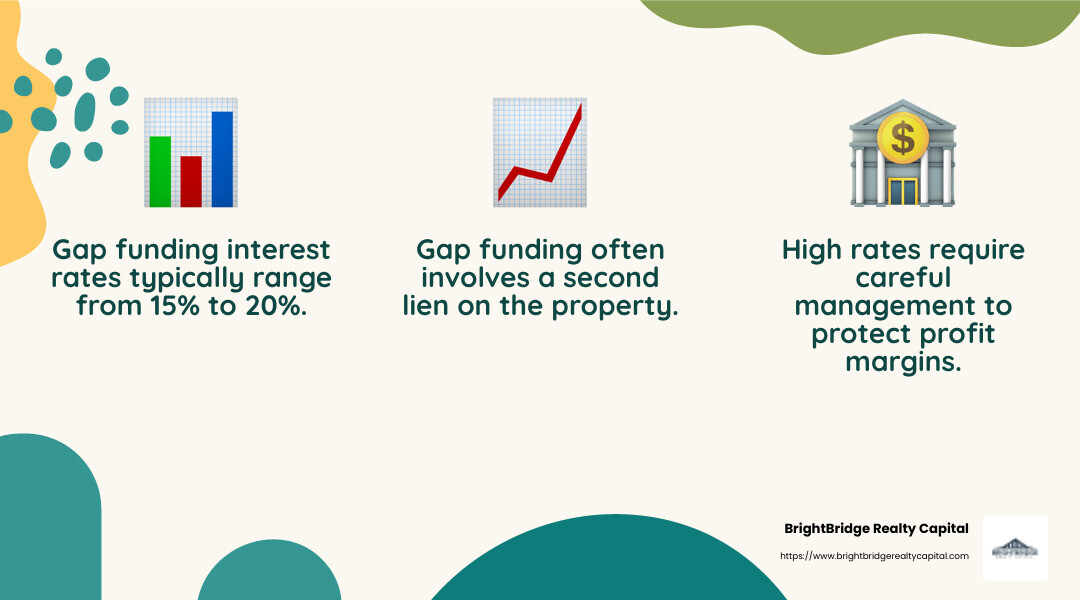Mind the Gap: Funding Your Fix and Flip Projects

Gap funding for fix and flip projects is a lifeline for many real estate investors. It bridges the difference between the primary loan and the total cost of a property flip, enabling investors to cover shortfalls without disturbing their capital reserves. Here's what you need to know:
- Gap Funding: Short-term capital to fill the gap between a primary loan and project costs.
- Fix and Flip: A strategy involving buying, renovating, and selling properties for profit.
- Real Estate Investors: Individuals or groups looking to maximize returns on investments through property developments.
For investors in the world of real estate, gap funding can mean the difference between a stalled project and a successful transaction. Real estate investment is lucrative, but securing full project funding can be challenging. That's where gap funding steps in, providing the critical support to keep projects on track and allow for multiple projects at the same time. By offering the means to overcome financial problems, gap funding keeps investors moving forward.
As interest rates fluctuate and housing demands shift, accessing reliable funding quickly can make or break an investment opportunity.

Understanding Gap Funding for Fix and Flip
Gap funding is a crucial component in fix and flip real estate. It acts as a bridge between the primary loan you secure from traditional lenders and the total cost of your project. This gap often arises because banks and other financial institutions typically cover only a portion of the purchase price and renovation costs.
What is Gap Funding?
Gap funding is a form of short-term financing that helps real estate investors cover these additional expenses. Think of it like a financial safety net that allows you to proceed with your fix and flip projects without tapping into your personal savings.
Why is it necessary? Traditional lenders often require substantial down payments and may not cover all renovation costs, leaving investors short on capital. Gap funding fills this void, ensuring that you can start and complete your renovations without financial strain.
The Role of a Second Mortgage
In many cases, gap funding is structured as a second mortgage. This means that it sits behind the primary loan in terms of repayment priority. While this can be a risky position for lenders, it provides investors with the additional funds needed to cover down payments, closing costs, and even some rehab expenses.

Benefits of Gap Funding
Flexibility: It allows you to manage multiple projects simultaneously, maximizing your investment potential.
Speed: Quick access to necessary funds ensures that your projects stay on schedule, reducing holding costs and increasing your return on investment (ROI).
Risk Management: By using gap funding instead of personal capital, you can minimize your financial risk and preserve cash reserves for future opportunities.
Challenges and Considerations
While gap funding is beneficial, it comes with high interest rates and fees. This is due to the risk lenders take on when issuing a second mortgage. Additionally, if a project fails, the gap lender is at a higher risk of loss since they are in a secondary position to the primary lender.
Understanding the dynamics of gap funding for fix and flip projects can help you make informed decisions and leverage opportunities effectively. As you move forward, consider the costs and benefits carefully to ensure that your investments are both profitable and sustainable.
How Gap Funding Works
Gap funding plays a vital role in the fix and flip process, especially when paired with hard money loans. These loans are often the first step for investors looking to purchase and renovate properties quickly. But sometimes, even these aren't enough to cover all expenses. That's where gap funding comes in.
The Role of Hard Money Loans
Hard money loans are short-term loans that provide immediate cash to real estate investors. They are typically used to purchase and renovate properties. Unlike traditional loans, they are based on the property's value rather than the borrower's creditworthiness.
- Quick Access: Hard money loans are known for their rapid approval process, often closing in as little as a week.
- Flexible Terms: These loans offer flexible repayment terms, which can be custom to fit the investor's timeline and project needs.
Filling the Financial Gaps
Even with a hard money loan, investors often face additional costs:
- Down Payment: Lenders usually require a down payment, which can be a significant upfront cost.
- Closing Costs: These include fees for property appraisal, inspection, and documentation, which can add up quickly.
Gap funding covers these extra expenses, ensuring that investors have the capital needed to proceed without delay. It acts as a second layer of financing, bridging the gap between the hard money loan and the total project cost.
How It Works in Practice
Imagine you're an investor who has secured a hard money loan to purchase a fixer-upper. The loan covers 70% of the property value, but you still need funds for a 20% down payment and other closing costs. This is where gap funding steps in, providing the necessary capital to cover these additional expenses.
Example Scenario
Let's say you find a property worth $200,000. A hard money lender offers you $140,000 (70% of the property value). You need an additional $40,000 for the down payment and $10,000 for closing costs. Gap funding can provide this $50,000, allowing you to move forward with the purchase and renovation.
The Bottom Line
By combining hard money loans with gap funding, real estate investors can cover all financial bases, ensuring their fix and flip projects are not stalled due to lack of funds. This strategy allows for quick project turnaround and maximizes potential profits.
As you steer real estate investment, understanding how to effectively use gap funding can be a game-changer for your projects. In the next section, we'll explore the pros and cons of gap funding to help you weigh your options.
Pros and Cons of Gap Funding
While gap funding can be a lifeline for real estate investors, it's crucial to understand both its benefits and drawbacks.
Pros of Gap Funding
Quick Access to Funds: Gap funding provides fast access to capital, which is essential for keeping projects on schedule. This can be particularly beneficial in competitive markets where delays might lead to lost opportunities.
Flexibility in Financing: Gap funding allows investors to pursue multiple projects simultaneously. By covering costs like down payments and closing fees, it frees up other resources to invest in additional properties.
Higher Potential ROI: With adequate funding, investors can target properties that require substantial renovations but promise higher returns. This can lead to improved profit margins once the property is sold.
Cons of Gap Funding
- High Interest Rates: One of the significant downsides is the high interest rates associated with gap funding. Rates can range from 15% to 20%, which can significantly cut into profits if not managed carefully.

Increased Risk: Gap funding often places a second lien on the property, which means it is riskier for both the lender and the borrower. If the project doesn't go as planned, the second lienholder may face losses.
Lender Challenges: Finding a reliable gap funder can be challenging. Investors need to ensure they partner with lenders who understand the real estate market and can offer terms that align with their project goals.
Case Study: Balancing Costs and Benefits
Consider an investor who secured a hard money loan for 80% of a property's purchase price. To cover the remaining costs, they pursued gap funding. While the gap funding allowed them to complete the renovation, the high interest rates reduced their overall profit margin by 10%.
This illustrates the need for careful financial planning when using gap funding to ensure that the benefits outweigh the costs.
The Bottom Line
While gap funding for fix and flip projects offers numerous advantages, it is not without its challenges. High interest rates and increased risk must be weighed against the potential for higher returns and faster project completion. Investors should carefully consider these factors before deciding if gap funding is the right choice for their real estate ventures.
In the next section, we'll explore alternatives to gap funding, offering other financial solutions that might better fit your investment strategy.
Alternatives to Gap Funding
If gap funding for fix and flip projects seems too risky or costly, there are several alternatives that might suit your needs better. Let's explore some options that can help you bridge the financial gap without the high interest rates of traditional gap funding.
Cross-Collateral Loans
Cross-collateral loans allow you to use the equity in one property to secure a loan for another. This can be a useful strategy if you have existing properties with significant equity.
Pros: Lower interest rates compared to gap funding and can leverage existing assets.
Cons: If you default, you risk losing multiple properties, as the loan is secured by more than one asset.
Personal Loans
A personal loan can be a quick way to access funds without tying them to a specific property. Many online lenders offer personal loans with fast approval processes.
Pros: No need for property as collateral, and the application process is straightforward.
Cons: Loan amounts are typically smaller, ranging from $10,000 to $50,000, and interest rates can still be high.
Seller Financing
Seller financing involves the property seller acting as the lender. They agree to finance the purchase, and you make payments directly to them.
Pros: Flexible terms and potentially lower interest rates. It can also be a quick way to close a deal.
Cons: Not all sellers are open to this arrangement, and you may still need to cover renovation costs separately.
Which Alternative is Right for You?
Choosing the best alternative to gap funding depends on your specific situation. Consider your existing assets, the amount of funding you need, and your risk tolerance. Each option has its pros and cons, so weigh them carefully to determine which aligns best with your investment strategy.
In the next section, we'll address some frequently asked questions about gap funding for fix and flip projects, helping you make informed decisions for your real estate investments.
Frequently Asked Questions about Gap Funding for Fix and Flip
What is gap funding?
Gap funding is short-term capital aimed at bridging the financial gap between your primary loan and total project costs in a fix and flip venture. Traditional lenders, like banks, often cover just a portion of the purchase and renovation expenses. This leaves a gap, which can stall your project. Gap funding helps fill this void, allowing you to proceed without financial hiccups.
How can I find gap funders?
Finding gap funders can be challenging but not impossible. Networking is key. Start by attending local real estate investment (REI) clubs. These gatherings are excellent places to meet potential funders and other investors who can share their experiences. You might also find leads through online real estate forums or by reaching out to private lenders who specialize in real estate investments.
Tip: Look into county title records to identify properties with second mortgages, as these might indicate active gap funders you can contact.
Is gap funding risky?
Yes, gap funding carries certain risks, primarily due to its high interest rates and the lender's position. Gap funders often take a second position behind your primary lender. This means if you default, the primary lender gets paid first, increasing the risk for the gap funder. Consequently, these loans can be expensive, with interest rates reaching up to 20% annually.
Moreover, if your project doesn't go as planned, you could face foreclosure, losing not only the property but also any equity you’ve invested. Always weigh the risks and costs before committing to gap funding.
In the next section, we'll wrap up with insights on how BrightBridge Realty Capital can assist you in navigating the complexities of fix and flip financing.
Conclusion
Navigating gap funding for fix and flip projects can be daunting, but it doesn't have to be. At BrightBridge Realty Capital, we specialize in providing real estate investors with the customized financing solutions they need to succeed. Our commitment to fast closings—often within just a week—ensures you can move quickly and capitalize on investment opportunities without unnecessary delays.
Flexible funding is at the core of our services. We understand that every project is unique, which is why we offer a range of loan options custom to meet your specific needs. Whether you're dealing with tight timelines or rising renovation costs, our solutions are designed to keep your project on track and your stress levels low.
By choosing BrightBridge Realty Capital, you're not just getting a lender; you're gaining a partner dedicated to helping you achieve your real estate investment goals. Our direct lending approach means there are no intermediaries, allowing us to offer competitive rates and a seamless process from start to finish.
Ready to take your fix and flip projects to the next level? Learn more about our services and find how BrightBridge Realty Capital can empower your investment journey.
Let's bridge the gap together and turn your real estate visions into reality.


